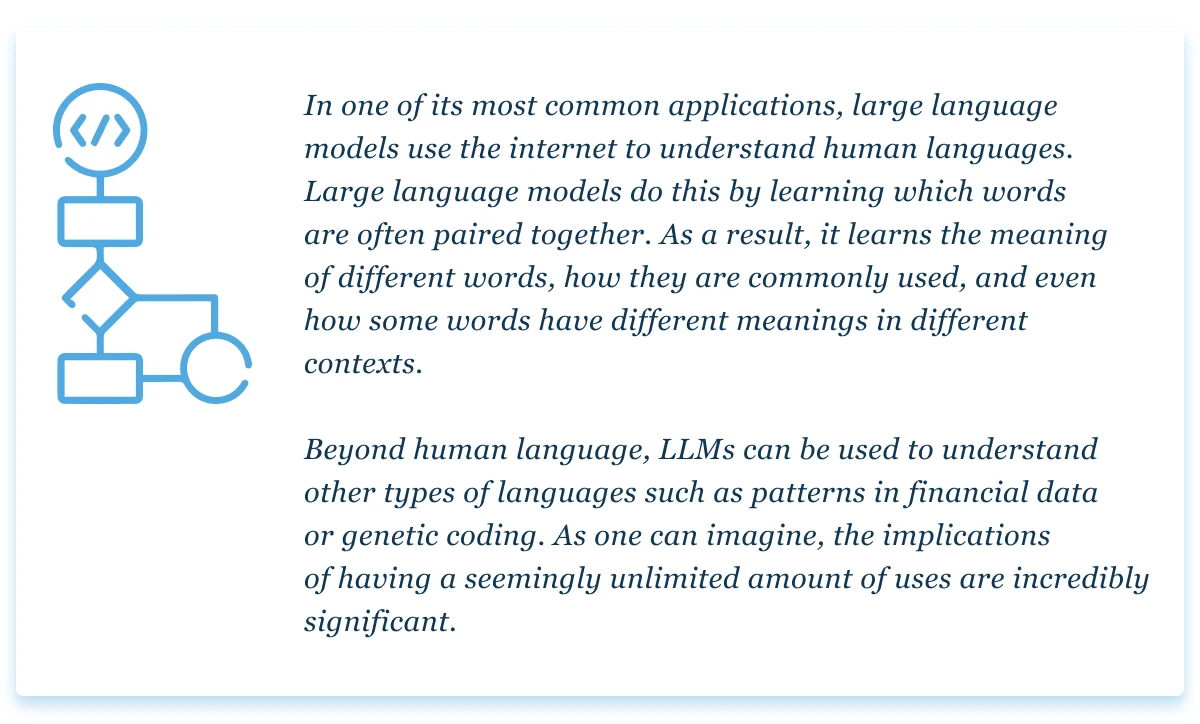AI and deep learning technology have ushered modern-day society into a new age. Specifically, large language model (LLM) use cases are widening the ways that humans can utilize this groundbreaking technology to create, organize, and understand the world.
This being the case, understanding the most exciting and useful large language model examples in today’s world is key to developing a more robust understanding of how immense of an impact LLM models are having on society and the way humans interact with technology.
In this blog, we’ll explore what large language models are, how they are able to function by utilizing machine learning and natural language processing technology, and the many different large language model use cases in existence today.
What are large language models?
Those exploring the various ways that AI is being used in our rapidly evolving world have probably had to ask themselves “What are large language models?” One of the main reasons for this is that content generation with ChatGPT, one of the most popular and accessible AI tools today, depends on language modeling to work.

However, while this can give you a cursory understanding of LLMs and how they work, to truly understand this technology it’s imperative to understand machine learning and the role it plays in language models.
LLM machine learning
To get a better grasp of what LLMs are and how they function, it’s vital to understand machine learning technology and how it works. In addition, it can be helpful to know the differences between deep learning vs. machine learning, which are two distinct processes.
Basically, machine learning technology is a form of AI that allows the software to learn on its own. Conversely, much like computer science and software engineering are related, deep learning is a specific type of machine learning that uses the concept of neural networks to help stimulate learning and understanding in programs.
Essentially, parameters are set in algorithms, and machine learning technology uses these as guidelines for how it should learn new things. For instance, in large language model examples, machine learning technology is tasked with learning everything it can about language, such as how words are used together and in what contexts, from a large database of language.
As a result of machine learning technology, large language models are able to respond to prompts and questions without being explicitly programmed to answer these questions. Instead, this technology is able to study and learn about different languages itself and create its own model of language which it can use to answer different prompts.
In this way, LLM machine learning is playing a key role in how AI technology is able to be applied to a range of different contexts in our rapidly expanding world. However, machine learning isn’t the only powerful piece of technology that helps bring LLM development to life. To gain a better perspective on how LLMs work, it’s imperative to understand natural language models and how they contribute to various large models and their functions.
NLP language model
While machine learning is one aspect of large language models that is important to understand, NLP language models are another facet that is equally important for people to familiarize themselves with.
Natural language processing is a part of AI that allows computers to understand human language in both spoken and written forms. Large language models utilize NLP language models to generate responses to prompts that seem like a person wrote them.
NLP language models are rapidly being adopted by organizations across industries and are estimated to grow in both value and adoption significantly over the next several years. This growth is mimicking the large-scale adoption of many other AI technologies that are proving to be incredibly useful in a variety of contexts.
Some applications of natural language processing to consider include information extraction, which is the process of extracting and organizing key types of information out of large data sets, and sentiment analysis, which analyzes large data sets of messages to distill the main sentiments being expressed.
In fact, ChatGPT uses NLP to perform a variety of functions. One of the main functions is to make answers to prompts and questions sound more human-like rather than computer generated. It’s this added component of human-like understanding of how language should be used that makes many large language models such as
Large language model use cases
To truly grasp the many varying ways that LLMs are helping society evolve it’s important to look at various large language model examples. Becoming familiar with the many different ways this technology is being used and the various aims these different uses are attempting to achieve is key to understanding LLMs.
Here are some of the most exciting large language model use cases.
Improving search engines and search results
Believe it or not, one of the most exciting new use cases for large language models is search engines. In particular, LLMs can make the process of searching for information more robust and streamlined in several key ways.
One way in which LLMs improve search engines and search results is by improving the scope of searches. For example, with the help of large models, people can now use a single search to scour various search engines and websites for information. This can improve workflows and productivity for employees across a range of industries.
Beyond being able to scour various sources, large language models also have the power to curate search results more effectively. This being the case, the experience of using search engines can be greatly improved for average people and advanced professionals alike with the help of LLMs.
Crafting marketing content
As many users of programs such as ChatGPT have discovered, many language model examples have an uncanny ability to create amazing content with simple prompts. This is already having significant implications for many businesses, with machine learning solutions now allowing operators to cut labor costs in substantial ways.

At this point in time, many in the marketing industry believe that these models don’t yet have a deep enough understanding of consumers to craft marketing content as well as marketing professionals. Despite this, creating marketing content has become one of the most common and exciting ChatGPT use cases for business in today’s business landscape.
While many larger corporations may still opt to pay marketing professionals, small business operators now have a way to craft professional marketing materials without the exorbitant costs typically associated with the practice. As a result, large language models are helping to make marketing more equitable for small businesses with smaller marketing budgets.
Customer support
One of the most exciting ways that these giant language models have impacted businesses is by providing customers with a more enjoyable and helpful customer support experience. Rather than having to wait an exorbitant amount of time for a person to help them, customers now have access to the immediate assistance of customer support systems and chatbots.
Customer support systems utilize LLM technology to respond effectively to questions, comments, and concerns of customers. The fact that customers can receive this feedback immediately means that customers will likely be more satisfied with their experience.
Beyond providing prompt assistance, these large language model-powered chatbots have the power to personalize responses to their specific users. The trend of personalized consumer experiences is rapidly gaining popularity among both consumers and organizations.
This being the case, LLMs have the power to help businesses improve their processes and provide their consumers with better, more robust experiences. As such, it’s no wonder that most recent artificial intelligence case studies have shown that many businesses are open to incorporating this technology into their processes.
Data management in healthcare
While a significant amount of media attention has been focused on AI’s ability to craft content, large language models also have the power to improve processes in the healthcare space.
One way that LLM technology is benefitting healthcare is by helping healthcare professionals transform and organize healthcare data more effectively. Specifically, LLM software is able to help these professionals create tables with this type of information far quicker than previous techniques used to do so.

Though it’s not yet being used on a large scale, many in the healthcare space are now looking for ways to incorporate chatbots into medical processes. Given that there is a shortage of medical professionals in many areas across the world, this approach could help patients receive medical insights quicker than current processes. However, this form of assistance is difficult as healthcare providers want to ensure that patients are receiving proper health-related information and it may be some time until it becomes normalized.
Understanding consumers
While the value of reviews and customer feedback has been known by organizations for decades, harnessing insights from consumer feedback has been a difficult process. This is because individuals each have their own way of leaving reviews, and scouring through all of them would take a considerable amount of time.
Fortunately, LLM technology has improved the situation in significant ways and presented itself as a promising data science solution to this problem. With the use of large language model programs, companies now have the ability to quickly analyze the feedback of consumers. This can provide key insight that benefits businesses in many ways.
In particular, using LLM programs can help companies who engage in a design thinking approach by helping them quickly analyze feedback and iterate their offerings to fit consumer preferences. As such, large language models provide businesses with an amazing way to understand their consumers and respond accordingly.
Improving education
In many ways, AI technology such as machine learning and LLM software have gained a bad reputation in educational contexts because of students’ ability to use them to generate content to use for assignments. However, these technologies and some machine learning companies are also presenting themselves as useful tools for helping students learn.

Source: Unsplash
One specific large language model use case in education is that of personalized teachers or tutors. Much like a chatbot, these programs can be asked specific questions about various educational topics. As a result, students have access to valuable help even when they don’t have access to a human teacher or tutor.
In addition to these chatbot educational helpers, large language models can help educators personalize lessons to the needs of individual students. This is an incredibly important development in education as the one-size-fits-all approach has been shown to be flawed in significant ways.
Another exciting way that this type of technology is being used to improve the education sector is through the use of NLP to enhance text analysis for remote education platforms. This includes gaining more insight into how students are learning by analyzing sentiments from their feedback. Ultimately, this can help to make remote education, which is quickly becoming a normalized form of education, more effective for a wider variety of students.
SEO optimization
As those in SEO understand, search engine algorithms are constantly evolving. This can make it difficult for organizations to ensure that their content is always showing up on search engine pages when consumers are searching for specific keywords.
Today, large language models play a key role in search engine processes. This means that ranking for specific keywords doesn’t just involve using that specific keyword anymore, but also involves using semantic context.
Fortunately, utilizing LLM software can help organizations understand how they should be optimizing their content for SEO purposes. As such, large language models can help organizations reach more consumers and grow their operations.
Providing people with a sense of connection and boosting mental health
While it may seem like a premise from a science-fiction novel, large language model programs are becoming advanced enough to provide people with a sense of human connection and, as a result, help people improve their mental health states.
Large language models are able to study a wide range of data about human interactions and conversations. As a result, they are able to generate responses to questions and prompts that make users feel like another human is conversing with them.

Source: Unsplash
For individuals struggling with feelings of loneliness and isolation, LLM programs can be a way to improve mental health and feel more connected to others. This can also be a cheaper form of mental health care than therapies, making mental health care more equitable for more people.
Product description generation
For the many businesses out there selling physical products, large language models can be incredibly useful for creating product descriptions. When programmed correctly, LLM programs can create compelling and accurate descriptions as well as SEO-optimized ones.
This is especially significant for small business owners who can’t yet afford to hire technical writers or SEO specialists to craft descriptions of products. In this way, large language models can not only simplify the process of engaging in E-commerce but can also make business more equitable for small business operators and owners.
This example is one of the many ways that Big data and AI are changing businesses in the modern world. Given the rapid adoption and normalization of these technologies, it’s likely that LLM-produced product descriptions will be one of many permanent changes brought on by this shift in technology.
Detecting fraudulent financial activity
In the world of finance, large language models have the potential to be incredibly helpful in helping institutions detect fraudulent transactions. This is because just like spoken and written languages, financial data also has patterns. As such, LLM software can be programmed to understand how financial data typically appears in specific contexts and what should be cause for concern.
For banks and credit card companies, this can help to mitigate fraud by immediately raising red flags in the case of financial anomalies. Ultimately, this can save these institutions money while also providing users with more peace of mind.
Beyond financial institutions such as banks, large language models can help insurance companies detect fraudulent claims. This is especially helpful for specific insurance companies, such as healthcare insurance providers, who receive countless claims each day.
What these examples indicate is that LLMs may be able to significantly reduce instances of fraud across a range of industries by making them immediately detectable. This being the case, many are excited to see how this function of large language models evolves and becomes more widely adopted.
Crafting creative content
Though it’s been extremely polarizing, the ability of large language models to create creative content, such as narratives, has been astounding. Though these models are not yet able to generate their own unique ideas, they are able to combine ideas, themes, and topics from their databases in order to make new creations.
For many industries, this could potentially have significant implications, as utilizing large language models instead of paying writers can be much cheaper. For example, movie studios and publishing companies may soon be able to utilize large language models to create stories. This means being able to produce and sell content at a much faster rate than is currently possible.
For those working as creative writers, large language models can also be used as tools that help in the creative process — especially when using GPT integration services with this express purpose. For instance, writers can use these programs to generate novel ideas at a rapid pace that they can then put their own creative spin on.
This amazing ability to craft creative content at the click of a button is one of the main reasons that the public is fascinated by generative AI development companies and their new innovations.

Source: Unsplash
Spoken language translation in real-time
While there are currently programs that can quickly translate written text, soon large language models may make it possible to translate spoken language in real-time, likely using advanced concepts used by interpreters such as term extraction to achieve this goal. This would allow people to have coherent conversations while speaking to others who are conversing in an entirely different language.
As one can imagine, the implications of this type of large language model application would be extremely significant. This could spark new development in a variety of industries such as travel and even create entirely new industries that capitalize on this innovation. Though large language models haven’t been used to create a seamless technology of this type yet, many are hopeful that one may arise in the near future.
Conclusion
Large language models are playing an important role in the adoption and application of AI technology in today’s world. By utilizing both machine learning and natural language processing techniques, LLM programs are able to be used in many different ways.
While businesses can utilize large language models to do a variety of things, such as generate marketing content and product descriptions, everyday users also can utilize the technology in exciting ways, such as generating creative content and getting better search engine results.
Ultimately, large language models are helping the world evolve in many exciting and significant ways. As time goes on and this technology continues to become more advanced and accessible, LLMs will likely become a normalized part of our world in both business and everyday life.
Be there for your customers 24/7 with LLM development
Provide personalized messaging and upscale customer service with a custom chatbot developed according to your needs. Contact us, and our consultants will reach out to you for a discussion.



